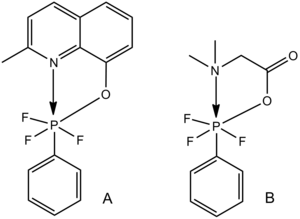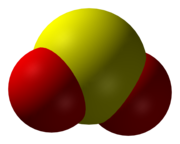A hypervalent molecule (the phenomenon is sometimes colloquially known as expanded octet) is a molecule that contains one or more main group elements apparently bearing more than eight electrons in their valence shells. Phosphorus pentachloride (PCl5), sulfur hexafluoride (SF6), chlorine trifluoride (ClF3), the chlorite (ClO2−) ion, and the triiodide (I3−) ion are examples of hypervalent molecules.
Definitions and nomenclature
Hypervalent
molecules were first formally defined by Jeremy I. Musher in 1969 as
molecules having central atoms of group 15–18 in any valence other than the lowest (i.e. 3, 2, 1, 0 for Groups 15, 16, 17, 18 respectively, based on the octet rule).
Several specific classes of hypervalent molecules exist:
- Hypervalent iodine compounds are useful reagents in organic chemistry (e.g. Dess–Martin periodinane)
- Tetra-, penta- and hexavalent phosphorus, silicon, and sulfur compounds (ex. PCl5, PF5, SF6, sulfuranes and persulfuranes)
- Noble gas compounds (ex. xenon tetrafluoride, XeF4)
- Halogen polyfluorides (ex. ClF5)
N-X-L notation
N-X-L nomenclature, introduced collaboratively by the research groups of Martin, Arduengo, and Kochi in 1980, is often used to classify hypervalent compounds of main group elements, where:
- N represents the number of valence electrons
- X is the chemical symbol of the central atom
- L the number of ligands to the central atom
Examples of N-X-L nomenclature include:
History and controversy
The debate over the nature and classification of hypervalent molecules goes back to Gilbert N. Lewis and Irving Langmuir and the debate over the nature of the chemical bond in the 1920s.
Lewis maintained the importance of the two-center two-electron (2c-2e)
bond in describing hypervalence, thus using expanded octets to account
for such molecules. Using the language of orbital hybridization, the
bonds of molecules like PF5 and SF6 were said to be constructed from sp3dn
orbitals on the central atom. Langmuir, on the other hand, upheld the
dominance of the octet rule and preferred the use of ionic bonds to
account for hypervalence without violating the rule (e.g. "SF42+ 2F−" for SF6).
In the late 1920s and 1930s, Sugden argued for the existence of a
two-center one-electron (2c-1e) bond and thus rationalized bonding in
hypervalent molecules without the need for expanded octets or ionic bond
character; this was poorly accepted at the time. In the 1940s and 1950s, Rundle and Pimentel popularized the idea of the three-center four-electron bond,
which is essentially the same concept which Sugden attempted to advance
decades earlier; the three-center four-electron bond can be
alternatively viewed as consisting of two collinear two-center
one-electron bonds, with the remaining two nonbonding electrons
localized to the ligands.
The attempt to actually prepare hypervalent organic molecules began with Hermann Staudinger and Georg Wittig
in the first half of the twentieth century, who sought to challenge the
extant valence theory and successfully prepare nitrogen and
phosphorus-centered hypervalent molecules. The theoretical basis for hypervalency was not delineated until J.I. Musher's work in 1969.
In 1990, Magnusson published a seminal work definitively
excluding the significance of d-orbital hybridization in the bonding of
hypervalent compounds of second-row elements. This had long been a
point of contention and confusion in describing these molecules using molecular orbital theory.
Part of the confusion here originates from the fact that one must
include d-functions in the basis sets used to describe these compounds
(or else unreasonably high energies and distorted geometries result),
and the contribution of the d-function to the molecular wavefunction is
large. These facts were historically interpreted to mean that
d-orbitals must be involved in bonding. However, Magnusson concludes in
his work that d-orbital involvement is not implicated in hypervalency.
Nevertheless, a 2013 study showed that although the Pimentel
ionic model best accounts for the bonding of hypervalent species, the
energetic contribution of an expanded octet structure is also not null.
In this modern valence bond theory study of the bonding of xenon difluoride,
it was found that ionic structures account for about 81% of the overall
wavefunction, of which 70% arises from ionic structures employing only
the p orbital on xenon while 11% arises from ionic structures employing
an hybrid on xenon. The contribution of a formally hypervalent structure employing an orbital of sp3d
hydridization on xenon accounts for 11% of the wavefunction, with a
diradical contribution making up the remaining 8%. The 11% sp3d contribution results in a net stabilization of the molecule by 7.2 kcal (30 kJ) mol−1, a minor but significant fraction of the total energy of the total bond energy (64 kcal (270 kJ) mol−1). Other studies have similarly found minor but non-negligible energetic contributions from expanded octet structures in SF6 (17%) and XeF6 (14%).
Despite the lack of chemical realism, the IUPAC recommends the
drawing of expanded octet structures for functional groups like sulfones
and phosphoranes, in order to avoid the drawing of a large number of
formal charges or partial single bonds.
Criticism
Both the term and concept of hypervalency still fall under criticism. In 1984, in response to this general controversy, Paul von Ragué Schleyer proposed the replacement of 'hypervalency' with use of the term hypercoordination because this term does not imply any mode of chemical bonding and the question could thus be avoided altogether.
The concept itself has been criticized by Ronald Gillespie
who, based on an analysis of electron localization functions, wrote in
2002 that "as there is no fundamental difference between the bonds in
hypervalent and non-hypervalent (Lewis octet) molecules there is no
reason to continue to use the term hypervalent."
For hypercoordinated molecules with electronegative ligands such as PF5
it has been demonstrated that the ligands can pull away enough electron
density from the central atom so that its net content is again 8
electrons or fewer. Consistent with this alternative view is the finding
that hypercoordinated molecules based on fluorine ligands, for example
PF5 do not have hydride counterparts e.g. phosphorane PH5 which is unknown.
The ionic model holds up well in thermochemical calculations. It predicts favorable exothermic formation of PF4+F− from phosphorus trifluoride PF3 and fluorine F2 whereas a similar reaction forming PH4+H− is not favorable.
Alternative definition
Durrant has proposed an alternative definition of hypervalency, based on the analysis of atomic charge maps obtained from Atoms in molecules theory.
This approach defines a parameter called the valence electron
equivalent, γ, as “the formal shared electron count at a given atom,
obtained by any combination of valid ionic and covalent resonance forms
that reproduces the observed charge distribution”. For any particular
atom X, if the value of γ(X) is greater than 8, that atom is
hypervalent. Using this alternative definition, many species such as
PCl5, SO42−, and XeF4, that
are hypervalent by Musher's definition, are reclassified as
hypercoordinate but not hypervalent, due to strongly ionic bonding that
draws electrons away from the central atom. On the other hand, some
compounds that are normally written with ionic bonds in order to conform
to the octet rule, such as ozone O3, nitrous oxide NNO, and trimethylamine N-oxide (CH3)3NO, are found to be genuinely hypervalent. Examples of γ calculations for phosphate PO43− (γ(P) = 2.6, non-hypervalent) and orthonitrate NO43− (γ(N) = 8.5, hypervalent) are shown below.
Calculation of the valence electron equivalent for phosphate and orthonitrate
Bonding in hypervalent molecules
Early considerations of the geometry of hypervalent molecules returned familiar arrangements that were well explained by the VSEPR model for atomic bonding. Accordingly, AB5 and AB6
type molecules would possess a trigonal bi-pyramidal and octahedral
geometry, respectively. However, in order to account for the observed
bond angles, bond lengths and apparent violation of the Lewis octet rule, several alternative models have been proposed.
In the 1950s an expanded valence shell treatment of hypervalent
bonding was adduced to explain the molecular architecture, where the
central atom of penta- and hexacoordinated molecules would utilize d AOs
in addition to s and p AOs. However, advances in the study of ab initio
calculations have revealed that the contribution of d-orbitals to
hypervalent bonding is too small to describe the bonding properties, and
this description is now regarded as much less important. It was shown that in the case of hexacoordinated SF6,
d-orbitals are not involved in S-F bond formation, but charge transfer
between the sulfur and fluorine atoms and the apposite resonance
structures were able to account for the hypervalency.
Additional modifications to the octet rule have been attempted to
involve ionic characteristics in hypervalent bonding. As one of these
modifications, in 1951, the concept of the 3-center 4-electron (3c-4e) bond, which described hypervalent bonding with a qualitative molecular orbital,
was proposed. The 3c-4e bond is described as three molecular orbitals
given by the combination of a p atomic orbital on the central atom and
an atomic orbital from each of the two ligands
on opposite sides of the central atom. Only one of the two pairs of
electrons is occupying a molecular orbital that involves bonding to the
central atom, the second pair being non-bonding and occupying a
molecular orbital composed of only atomic orbitals from the two ligands.
This model in which the octet rule is preserved was also advocated by
Musher.
Qualitative model for a three-center four-electron bond
Molecular orbital theory
A
complete description of hypervalent molecules arises from consideration
of molecular orbital theory through quantum mechanical methods. A LCAO
in, for example, sulfur hexafluoride, taking a basis set of the one
sulfur 3s-orbital, the three sulfur 3p-orbitals, and six octahedral
geometry symmetry-adapted linear combinations (SALCs) of fluorine
orbitals, a total of ten molecular orbitals are obtained (four fully
occupied bonding MOs of the lowest energy, two fully occupied
intermediate energy non-bonding MOs and four vacant antibonding MOs with
the highest energy) providing room for all 12 valence electrons. This
is a stable configuration only for SX6 molecules containing electronegative ligand atoms like fluorine, which explains why SH6 is not a stable molecule. In the bonding model, the two non-bonding MOs (1eg) are localized equally on all six fluorine atoms.
Valence bond theory
For hypervalent compounds in which the ligands are more electronegative than the central, hypervalent atom, resonance structures
can be drawn with no more than four covalent electron pair bonds and
completed with ionic bonds to obey the octet rule. For example, in phosphorus pentafluoride (PF5),
5 resonance structures can be generated each with four covalent bonds
and one ionic bond with greater weight in the structures placing ionic
character in the axial bonds, thus satisfying the octet rule and
explaining both the observed trigonal bipyramidal molecular geometry and the fact that the axial bond length (158 pm) is longer than the equatorial (154 pm).
Phosphorus pentafluoride. There are 2 structures with an axial ionic bond, plus 3 structures with an equatorial ionic bond.
For a hexacoordinate molecule such as sulfur hexafluoride,
each of the six bonds is the same length. The rationalization
described above can be applied to generate 15 resonance structures each
with four covalent bonds and two ionic bonds, such that the ionic
character is distributed equally across each of the sulfur-fluorine
bonds.
Sulfur hexafluoride. There are 12 structures with the two ionic bonds in adjacent (cis) positions, plus 3 structures with the two ionic bonds in opposite (trans) positions.
Spin-coupled valence bond theory has been applied to diazomethane
and the resulting orbital analysis was interpreted in terms of a
chemical structure in which the central nitrogen has five covalent
bonds.
Chemical formula of diazomethane, showing hypervalent nitrogen
This led the authors to the interesting conclusion that "Contrary to
what we were all taught as undergraduates, the nitrogen atom does indeed
form five covalent linkages and the availability or otherwise of
d-orbitals has nothing to do with this state of affairs."
Structure, reactivity, and kinetics
Structure
Hexacoordinated phosphorus
Hexacoordinate phosphorus molecules involving nitrogen, oxygen, or sulfur ligands provide examples of Lewis acid-Lewis base hexacoordination.
For the two similar complexes shown below, the length of the C-P bond
increases with decreasing length of the N-P bond; the strength of the
C-P bond decreases with increasing strength of the N-P Lewis acid-Lewis
base interaction.
Relative
bond strengths in hexacoordinated phosphorus compounds. In A, the N-P
bond is 1.980Å long and the C-P is 1.833Å long, and in B, the N-P bond
increases to 2.013Å as the C-P bond decreases to 1.814Å.
Pentacoordinated silicon
This
trend is also generally true of pentacoordinated main-group elements
with one or more lone-pair-containing ligand, including the
oxygen-pentacoordinated silicon examples shown below.
Relative
bond strengths in pentacoordinated silicon compounds. In A, the Si-O
bond length is 1.749Å and the Si-I bond length is 3.734Å; in B, the Si-O
bond lengthens to 1.800Å and the Si-Br bond shortens to 3.122Å, and in
C, the Si-O bond is the longest at 1.954Å and the Si-Cl bond the
shortest at 2.307A.
The Si-halogen bonds range from close to the expected van der Waals
value in A (a weak bond) almost to the expected covalent single bond
value in C (a strong bond).
Reactivity
Silicon
| Chlorosilane | Nucleophile | kobs (M−2s−1) at 20 °C in anisole |
|---|---|---|
| Ph3SiCl | HMPT | 1200 |
| Ph3SiCl | DMSO | 50 |
| Ph3SiCl | DMF | 6 |
| MePh2SiCl | HMPT | 2000 |
| MePh2SiCl | DMSO | 360 |
| MePh2SiCl | DMF | 80 |
| Me(1-Np)PhSiCl | HMPT | 3500 |
| Me(1-Np)PhSiCl | DMSO | 180 |
| Me(1-Np)PhSiCl | DMF | 40 |
| (1-Np)Ph(vinyl)SiCl | HMPT | 2200 |
| (1-Np)Ph(vinyl)SiCl | DMSO | 90 |
| (1-Np)(m-CF3Ph)HSiCl | DMSO | 1800 |
| (1-Np)(m-CF3Ph)HSiCl | DMF | 300 |
Corriu and coworkers performed early work characterizing reactions thought to proceed through a hypervalent transition state. Measurements of the reaction rates of hydrolysis of tetravalent chlorosilanes incubated with catalytic amounts of water returned a rate that is first order
in chlorosilane and second order in water. This indicated that two
water molecules interacted with the silane during hydrolysis and from
this a binucleophilic reaction mechanism was proposed. Corriu and
coworkers then measured the rates of hydrolysis in the presence of
nucleophilic catalyst HMPT, DMSO or DMF. It was shown that the rate of
hydrolysis was again first order in chlorosilane, first order in
catalyst and now first order in water. Appropriately, the rates of
hydrolysis also exhibited a dependence on the magnitude of charge on the
oxygen of the nucleophile.
Taken together this led the group to propose a reaction mechanism
in which there is a pre-rate determining nucleophilic attack of the
tetracoordinated silane by the nucleophile (or water) in which a
hypervalent pentacoordinated silane is formed. This is followed by a
nucleophilic attack of the intermediate by water in a rate determining
step leading to hexacoordinated species that quickly decomposes giving
the hydroxysilane.
Silane hydrolysis was further investigated by Holmes and coworkers in which tetracoordinated Mes2SiF2 (Mes = mesityl) and pentacoordinated Mes2SiF3−
were reacted with two equivalents of water. Following twenty-four
hours, almost no hydrolysis of the tetracoordinated silane was observed,
while the pentacoordinated silane was completely hydrolyzed after
fifteen minutes. Additionally, X-ray diffraction data collected for the
tetraethylammonium salts of the fluorosilanes showed the formation of
hydrogen bisilonate lattice supporting a hexacoordinated intermediate
from which HF2− is quickly displaced leading to
the hydroxylated product. This reaction and crystallographic data
support the mechanism proposed by Corriu et al.
Mechanism of silane hydrolysis and structure of the hydrogen bisilonate lattice
The apparent increased reactivity of hypervalent molecules,
contrasted with tetravalent analogues, has also been observed for
Grignard reactions. The Corriu group measured
Grignard reaction half-times by NMR for related 18-crown-6 potassium
salts of a variety of tetra- and pentacoordinated fluorosilanes in the
presence of catalytic amounts of nucleophile.
Though the half reaction method is imprecise, the magnitudinal
differences in reactions rates allowed for a proposed reaction scheme
wherein, a pre-rate determining attack of the tetravalent silane by the
nucleophile results in an equilibrium between the neutral
tetracoordinated species and the anionic pentavalent compound. This is
followed by nucleophilic coordination by two Grignard reagents as
normally seen, forming a hexacoordinated transition state and yielding
the expected product.
Grignard reaction mechanism for tetracoordinate silanes and the analogous hypervalent pentacoordinated silanes
The mechanistic implications of this are extended to a
hexacoordinated silicon species that is thought to be active as a
transition state in some reactions. The reaction of allyl- or crotyl-trifluorosilanes
with aldehydes and ketones only precedes with fluoride activation to
give a pentacoordinated silicon. This intermediate then acts as a Lewis acid
to coordinate with the carbonyl oxygen atom. The further weakening of
the silicon–carbon bond as the silicon becomes hexacoordinate helps
drive this reaction.
Phosphorus
Similar
reactivity has also been observed for other hypervalent structures such
as the miscellany of phosphorus compounds, for which hexacoordinated
transition states have been proposed.
Hydrolysis of phosphoranes and oxyphosphoranes have been studied and shown to be second order in water. Bel'skii et al..
have proposed a prerate determining nucleophilic attack by water
resulting in an equilibrium between the penta- and hexacoordinated
phosphorus species, which is followed by a proton transfer involving the
second water molecule in a rate determining ring-opening step, leading
to the hydroxlyated product.
Mechanism of the hydrolysis of pentacoordinated phosphorus
Alcoholysis of pentacoordinated phosphorus compounds, such as
trimethoxyphospholene with benzyl alcohol, have also been postulated to
occur through a similar octahedral transition state, as in hydrolysis,
however without ring opening.
Mechanism of the base catalyzed alcoholysis of pentacoordinated phosphorus
It can be understood from these experiments that the increased
reactivity observed for hypervalent molecules, contrasted with analogous
nonhypervalent compounds, can be attributed to the congruence of these
species to the hypercoordinated activated states normally formed during
the course of the reaction.
Ab initio calculations
The
enhanced reactivity at pentacoordinated silicon is not fully
understood. Corriu and coworkers suggested that greater electropositive
character at the pentavalent silicon atom may be responsible for its
increased reactivity. Preliminary ab initio calculations supported this hypothesis to some degree, but used a small basis set.
A software program for ab initio calculations, Gaussian 86, was used by Dieters and coworkers to compare tetracoordinated silicon and phosphorus to their pentacoordinate analogues. This ab initio
approach is used as a supplement to determine why reactivity improves
in nucleophilic reactions with pentacoordinated compounds. For silicon,
the 6-31+G* basis set was used because of its pentacoordinated anionic character and for phosphorus, the 6-31G* basis set was used.
Pentacoordinated compounds should theoretically be less
electrophilic than tetracoordinated analogues due to steric hindrance
and greater electron density from the ligands, yet experimentally show
greater reactivity with nucleophiles than their tetracoordinated
analogues. Advanced ab initio calculations were performed on series of
tetracoordinated and pentacoordinated species to further understand this
reactivity phenomenon. Each series varied by degree of fluorination.
Bond lengths and charge densities are shown as functions of how many
hydride ligands are on the central atoms. For every new hydride, there
is one less fluoride.
For silicon and phosphorus bond lengths, charge densities, and Mulliken
bond overlap, populations were calculated for tetra and pentacoordinated
species by this ab initio approach.
Addition of a fluoride ion to tetracoordinated silicon shows an overall
average increase of 0.1 electron charge, which is considered
insignificant. In general, bond lengths in trigonal bipyramidal
pentacoordinate species are longer than those in tetracoordinate
analogues. Si-F bonds and Si-H bonds both increase in length upon
pentacoordination and related effects are seen in phosphorus species,
but to a lesser degree. The reason for the greater magnitude in bond
length change for silicon species over phosphorus species is the
increased effective nuclear charge at phosphorus. Therefore, silicon is
concluded to be more loosely bound to its ligands.
In addition Dieters and coworkers show an inverse correlation between bond length and bond overlap for
all series. Pentacoordinated species are concluded to be more reactive
because of their looser bonds as trigonal-bipyramidal structures.
By calculating the energies for the addition and removal of a
fluoride ion in various silicon and phosphorus species, several trends
were found. In particular, the tetracoordinated species have much higher
energy requirements for ligand removal than do pentacoordinated
species. Further, silicon species have lower energy requirements for
ligand removal than do phosphorus species, which is an indication of
weaker bonds in silicon.




























